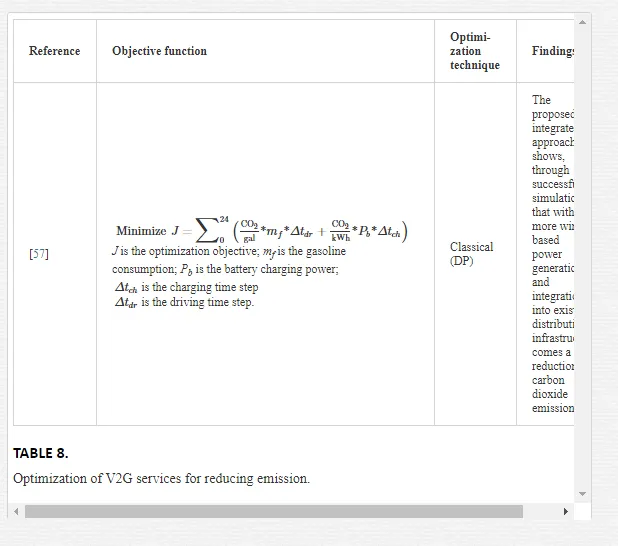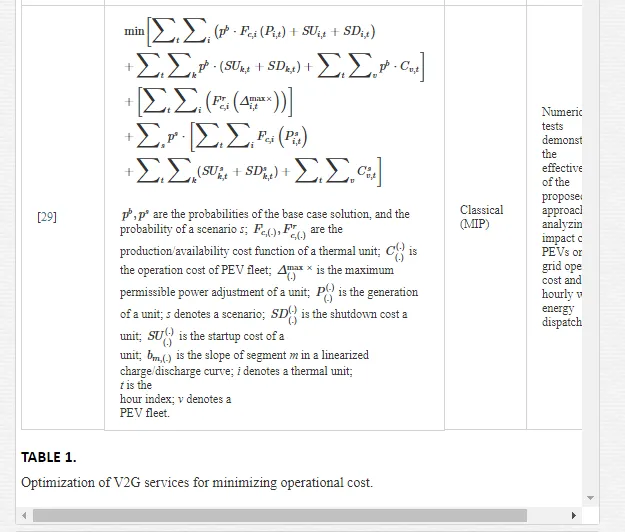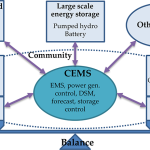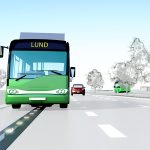The world is presently facing many energy problems. Fossil fuels have been the main dominant energy source for both the transportation sector and power generation industry even if this energy source produces greenhouse gases (GHGs) which have a negative impact on climate change [1]. With fossil fuel prices increasing and its negative environmental impact, oil is becoming less of a long-term energy solution, and more renewable sources of energy are being sought. Wind and photovoltaic solar are renewable energy (RE) sources that are rapidly replacing conventional power sources. On the other hand, electric vehicles (EVs) are becoming more and more popular due to the fewer emission and low oil dependency.
The electrical vehicle is a zero emission vehicle because it does not produce the pollution associated with internal combustion engines (ICEs). However, the charging through fossil-fuelled electrical generation still makes an environment impact since most electricity is generated by burning fossil fuels. But comparing with cars operated by gas power, cars operated by batteries are cleaner because they produce less carbon emissions. Moreover, battery-powered motors cost less to operate. The other advantage of EVs is safety and efficiency. EVs use the advance technology to maintain the vehicle adequately and to keep the right supplies on hand in case of emergencies. EVs offer benefits to the transportation sector and the electric power system. They help strengthen the economy, are more environmentally friendly, and can reduce strain on the petroleum industry by using renewable generation, especially photovoltaic solar and wind, which is an important part of the transition to cleaner sources of power. EVs are the best option for greener and economic driving [2].
An electric vehicle (EV) is considered an electrical drive vehicle which uses one or more electrical motors or traction motor for propulsion. An EV is powered through a collector system by electricity from a self-contained battery or generator to convert fuel to electricity. These are termed battery electric vehicles (BEVs), or if powered with an off vehicle source, termed plug-in hybrid electric vehicles (PHEVs) [3].
The battery electric vehicle is one type of electrical vehicle that uses chemical energy stored in rechargeable battery packs. There are three major parts in the typical architecture of BEVS: electric motor, rechargeable battery, and controller. The electric motor uses a rechargeable battery as an energy source to generate propulsion. The controller manages the power supplied to the electric motor. Another important part of a BEV is the inverter, which is for converting the electricity stored in the battery (DC) power to alternating current (AC) power [3]. The Nissan Leaf is a battery electric vehicle which relies on the grid to recharge its battery. Its battery packs can be charged from fully discharged to 80% capacity in about 30 minutes using DC fast charging. It does not produce pollution or GHGs, and also helps to reduce dependence on petroleum [4].
The plug-in hybrid electric vehicle is a hybrid electrical vehicle that can use rechargeable batteries or another energy storage device. They are usually equipped with both an electric motor and an additional internal combustion engine for propulsion. PHEVs can be driven in two modes: charge depleting (CD) and charge sustaining (CS). PHEVs produce energy from on-board battery packs when they operate in CD mode, and they switch to CS mode and utilize the ICE system for further propulsion if the charge of the battery has been depleted to a predetermined level. There are three categories of plug-in hybrid vehicle: parallel hybrid, series hybrid, and power-split hybrid. The parallel hybrid is the most commonly adopted. They use both electric motor and an engine to power the driven wheels in a car [3]. The Toyota Prius is a hybrid car with an internal combustion engine. Its large on-board battery recharges while the gasoline-fuelled ICE is running. It is fully self-sufficient and does not rely on the grid. It can use its large on-board battery for 34–40 miles before the on-board gasoline generator kicks in. It is fully capable of making long trips, but can also go short distance powered entirely by the battery without any gasoline [5].
Vehicle to grid (V2G)
CONCEPT
The advancement of EV technology has brought on additional attention into the integration of the transportation sector into the power grid. The control and management of EV loads by the power utility using the communication between vehicles and the power grid is referred to as vehicle to grid. Some other similar concepts are vehicle to home (V2H) and vehicle to vehicle (V2V). These involve exchanging power between an individual’s home power network and their vehicle, or exchanging power within a community of electric vehicles [6].
Currently, the transportation sector is primarily using gasoline or petrol for propulsion, and does not have any interconnection capabilities with the power grid. However, with the advancing adoption of EV into the transportation market, the idea of allowing EVs to plug into the power grid, to not only charge their vehicles, but also discharge energy back into the grid, becomes more practical [2].
The V2G concept could provide many services to power grid but presents some challenges as well. The benefits of such a system include peak load shaving, load leveling, and voltage regulation, which will ultimately result in maximizing profits. The challenges include the logistics of retrofitting the current infrastructures and gaining the support of the public and policy makers.
One issue includes the accelerated battery degradation due to increasing the charging cycles of each vehicle’s battery. Studies are being conducted to collect more accurate data on battery lifecycles. These studies will provide more information so that policy makers can either prevent consumers’ battery degradation, or more accurately consider the cost of that wear and implement that into the pricing scheme. The battery degradation scenario is part of the social barrier that V2G may present. Skeptical EV owners may wonder how they can be assured they will have enough energy stored in their vehicle to accommodate their transportation needs. There are also concerns of how the consumers will be fairly compensated for discharging their energy back into the grid.
The challenge of retrofitting the power grid infrastructure could be the biggest hurdle. Implementing V2G would be a large investment. Improving hardware and software in the grid system would be one major cost. Another would be adding a bidirectional battery charger to each EV. Bidirectional chargers consist of a complex controller and high tension cabling with stringent safety requirements. V2G implementation would mean frequent charge and discharge cycles resulting in more losses from energy conversions. A large fleet of EV’s charging and discharging would add up to large energy losses for the power system [6].
The overall concept of V2G began with the idea of tapping into the underutilized power capacity of the passenger vehicle fleet. Whether it is internal combustion or all electric, the vehicle fleet in the United States has much more energy capacity than all the U.S. electrical generating plants combined and they sit idle nearly 95% of the day. As the automobile industry begins to shift more toward electric and hybrid vehicle production, the utilities have begun to consider using these vehicle batteries as a storage cell. Studies have shown that even with unfavorable assumptions about cost and lifecycles of batteries, over a wide range of conditions, the value to the utility of tapping vehicle electrical storage exceeds the cost of a two-way hook-up and reduced battery life. It has been considered to offer incentives to the vehicle owner as a purchase subsidy, lower electric rates, or purchase and maintenance of successive vehicle batteries [7].
A possible configuration for an EV participating in V2G technologies would have a user interface with the vehicle allowing the owner to disable or limit the discharge to the grid. An intelligent charge controller could have several options for the owner to charge and discharge the vehicle. Some options could be to charge now or charge when cheap, or to set a minimum threshold to maintain enough charge for the owner to be able to cover a particular driving distance. This would allow for more flexibility for owners to participate as much as their lifestyle allows. An incentive-based program would hopefully garner more favor from consumers [7].
SMART GRID
A smart grid is a modernized electrical power grid that involves communication technology between the utility and the consumers using computer-based remote control and automation to improve reliability, efficiency, and sustainability of the power supply. Two-way communication between the utility and its customers by way of sensors and smart meters throughout the smart grid are used for real-time data acquisition. The data collected from these sensors and smart meters are then used by intelligent and autonomous monitoring control to supervise and optimize the overall operations of the interconnected components [2].
An additional characteristic that separates the smart grid from the conventional grid is that consumers can actively participate in the grid operation. The smart grid would contain advanced metering infrastructure that would allow for consumers to access the real-time information about electricity usage, tariff, and incentive information. They can use this information for their own gain by adjusting electricity usage patterns and preferences. These adjustments would likely help to balance out the overall energy supply and demand. The smart grid concept also incorporates a widely dispersed distribution of generation units from various forms of renewable generation and conventional power sources. This variety of generation sources will provide better overall reliability and reduce risks from attacks and natural disasters [2].
The ability to accommodate renewable energy sources more efficiently is another attractive characteristic of the smart grid. Wind and PV solar energy has unpredictable and intermittent supply of power to the grid. Due to varying weather conditions, the power produced from these sources can be much higher than the power demand in some cases and much lower in other cases. They are variable with time and unable to dispatch on command. However, these sources are practically viable if able to store and later discharge excess energy. The promise of balancing the electricity generation from renewable sources with consumer load is realistic with energy storage systems and controllable dispatch loads. A smart grid that communicates supply and demand data will make renewable sources with energy storage systems a practical solution [1].
The smart grid can improve grid reliability and power quality but implementing it into existing infrastructure will be a challenge. In the meantime, there are several smart grid projects underway all over the world. According to the Global Smart Grid Federation Report, the leading projects are taking place in Australia; Ontario, Canada; London, Great Britain; Ireland; South Korea; and Houston, TX, in the United States [8].
SMART CHARGING/DISCHARGING
As EVs become more prevalent, a high concentration of vehicles charging over a small period of time will inevitably lead to overload conditions in local nodes of the grid. This could lead to interruptions and/or imbalances that would degrade the service quality, increase line losses, or damage equipment. Smart grids are fundamental in smart charging management strategies that can reduce peak load on the grid. This will also allow for the advantage of coordinating vehicle charging in order to store surplus grid energy at a given instant and inject it into the grid when needed [9].
The potentially undesirable effects of uncontrolled EV charging such as overloading the power system facility would lead to an unregulated, less efficient electrical supply. To alleviate this condition, some smart charging schemes have been developed to minimize charging costs. Some optimization algorithms have been developed to create a better solution for EV’s charging and discharging into the grid. Some smart charging concepts include using day-ahead energy resource scheduling for smart grid by considering all the dispersed energy resources (i.e., wind, solar, conventional, etc.) and the V2G participants. An optimization approach could be used for intelligent optimal scheduling. To facilitate this intelligent charging concept, a radio frequency identification (RFID) tag technology would be used to ID those plugging into the grid. Some options could be considered where EV owners could control and monitor their charging through a mobile web application. Parameters could be adjusted such as the desired state of charge, arrival and departure times, or options for the V2G services to maximize profit. Other intelligent charging models use consumption historical statistics with data mining approaches. This method could include using the GPS function on an EV owners’ mobile device to help determine driving characteristics [1].
Efforts have been made in developing smart charging strategies to account for the efficiency of the charging process. An effective dispatching strategy needs to account for the losses in the charging process to accurately estimate the amount of energy fed to the battery from the grid. Accounting for these nonideal conditions will allow for better overall system performance. Currently, the charging efficiency of batteries for electric transportation still is largely dependent on the charging rate due to the internal battery resistance. On a typical lithium-ion cell, the charging rate is normalized with respect to the battery capacity. The efficiency will decrease significantly with the charging rate due to the internal battery resistance power dissipation with the charging current. These charging characteristics need to be taken into account to develop smart charging strategies [9].
ADVANCED COMMUNICATION AND CONTROL
The critical portion of the smart grid is the communication and control aspect. A two-way communication network enables demand response technologies which can control distributed energy resources over dispersed geographical areas [1]. As smart grid capabilities increase with newer automation and communication networks, power utilities and aggregators are able to see real-time distribution and load demands on the network and, via the bidirectional communication, control and optimize the supply of power. A key benefit with EV is that they can act as energy storage units that interact with the smart grid, through “smart” charging stations. This dual-channel communication is only available through the use of bidirectional communication, not unilateral, which among other reasons makes the switch from non-EV to EV even more practical. These interactions can help optimize power distribution, decreasing degradation and increasing quality of deliverable power through active power support and reactive power compensation [2]. With an infrastructure of smart meters, the power system can obtain the information of power demand and consumption in the system to better schedule generation and distribution for locational pricing. With a large number of smart meters, fiber optics as a medium would not be feasible due to cost, and wireless communication would be the preferred method between smart meters and control centers [8]. The benefits of wireless include low cost infrastructure and wide area coverage [1]. Perhaps a hybrid wired/wireless system can be used in the future for security concerned consumers [10].
In comparison with traditional data networks, the smart meter network of a smart grid would have some unique challenges. One challenge would be the volume of traffic and limited bandwidth due to the large number of smart meters. Another would be the requirement for real-time data transmission. The power grid is a very dynamic system and it is critical to have current data. Delays in data transmission could result in instability to the power market. Another challenge would be taking the characteristics of the power systems into account for charge scheduling. Traditional scheduling algorithms that maximize the throughput or minimize the average delay may not be valid in a smart grid. Addressing these challenges could include introducing locational marginal pricing and a model of power load variation into a scheduling algorithm [10].
On the consumer side, there are several ideas on how EV owners can exercise control of their vehicle’s charging schedule while still allowing the power grid to benefit from the EV battery source. One idea would consider equipping each V2G compatible EV with a user interface device to allow the driver to receive instructions or seek advice for charging/discharging processes. An alert would be issued in the event when the EV’s battery capacity is below a predetermined threshold level. This alert can include near-by charging stations, distance, their energy price, etc. The alert can also provide the driver with instructions to bringing the vehicle to appropriate charging stations to serve as a backfill battery. All of this information exchange would be accomplished through wireless communication and hall-effect current sensors.
System architecture of a vehicle to grid communication system would possibly include several road side units that would communicate between passing vehicles, nearby charging stations, and the smart grid. The road side units would allow communication between vehicles and charging stations when the transmission ranges would not be sufficient. The data transfer would be triggered by the driver or a recommendation system. With a driver-triggered scenario, the driver checks the state of charge and seeks advice on charging through the user interface on board the EV. The communication module will send a message to the nearest road side unit to request information of near-by charging stations. The inquiry would generate a reply back to the vehicle with its geographical location and/or current energy price. The on-board controller would collect data through the message exchanges and start the recommendation system. This recommendation system would decide whether it is the right time to charge or not based on the vehicle’s state of charge, energy prices, and grid status. It would either recommend to charge or defer to off-peak hours when energy rates would likely be lower.
With a system-triggered scenario, the recommendation of energy charging depends on factors such as the grid load, the state of charge of the vehicle, and real-time energy prices. The system would receive alarms from sensors on the vehicle (for battery capacity), and then send messages to the road side units to start a recommendation process [11].
V2G services for renewable energy (RE) integration
V2G systems can provide a variety of services to power utilities, grid operators and aggregators, as well as the EV owner and even the environment. These services include ancillary services, time shifting, active power support, and reactive power compensation through voltage regulation. These services will become invaluable due to their mitigation of the increasing uncertainties and intermittencies of the grid due to the renewable energy integration [12, 13].
ANCILLARY SERVICES: SPINNING RESERVE
Ancillary service refers to the supporting service supplied to the power grid in order to improve upon and maintain the reliability and efficiency of the power grid, this also increases sustainability. There are several ancillary services that are required for the security, reliability, and stability of the grid. These services make up reactive supply, voltage control, regulation, operating spinning reserve, operating supplemental reserve, and restoring energy imbalance [14]. V2G technology inputs ancillary services to the power grid through a spinning reserve service, where the energy stored in the grid-connected EVs is utilized as an additional generation capacity to make up for the generation deficiencies due to generation outages [15]. The spinning reserve service provided by V2G technology provides a platform to initiate failure recovery, as well as reduce the backup generation capacity [16, 17].
TIME SHIFTING
In time shifting services, storage capabilities and technologies are required to necessitate and provide energy within a timeframe of 5–12 hours. In this particular case, energy storage systems are required to absorb and assimilate all of the energy from RESs during off-peak demand periods. This absorbed energy may be supplemented with cheaper alternative power sources brought from the network if necessary, and then selling it during peak power demand periods; mitigating the activation or update of other conventional and more mainstream peak power generation plants [18].
ACTIVE POWER SUPPORT
EV can provide numerous methods of active power support. Through bidirectional communication, the excessive EVs energy that would otherwise be wasted can be sent back to the utilities and aggregators via the smart grid through specialized charging stations, parking lots, etc. The goal of active power support is to ease the demand on the power utilities. The demand for power is not constant, in that demand ebbs and flows, with a decrease in the late nights and sizable demands during the mid-day and early mornings. This fluctuation degrades the generative power of utilities. In addition, utility customers see the prices of electricity change in accordance to the demands; having to pay a premium price for electricity usage during peak hours. Power systems are designed for worst-case conditions, that is, assuming maximum load and demand. It follows that whenever the demand is less than maximum, the systems are being underutilized. Operating at maximum capacity also wears out the system over its life time. EVs are able to provide two kinds of active power support, load leveling and peak shaving, to prolong power system longevity and lower the economic strain on consumers and EV owners [2].
LOAD LEVELING
Load leveling is the goal to “spread out” the high demand curve during peak hours, thus decreasing the operational strain on the systems. EVs act, when on the V2G scale, as a collective distribution network to supply excess power back through the smart grid to level out the load peak. By using smarter distribution networks, the demand for sole generation and distribution felt by power utilities and aggregators is lessened, prolonging system life and mitigating unnecessary costs of repairs or upgrades. Utilizing the power systems at a level less than peak for a longer period of time will lead to less loses overall, prolonging usability and lowering overloading chances. Due to the stochastic nature of weather-dependent renewable resources, the output power is unreliable to constantly meet the load. Using distribution networks to store excess energy, like EVs, to act as a buffer to provide power whenever levels of renewable generation is not at demand will allow year-round operation of renewables through lowered reliance on perfect weather conditions [19].
PEAK SHAVING
By allowing the power systems to not operate at worst-case peak levels, the degradation of the systems is lessened and the overall life of the system and its generative abilities are increased. This allows for longer and higher quality power distribution. EV connected to the grid during peak hours increases the load at the low-voltage network. This increases the demand for current and consequently the need for power from the medium and high-voltage networks. The increased load will force more current through transmission cables and transformers from high- and medium-voltage networks down to low-voltage networks, which in turn increases transmission losses and thermal wear on components, decreasing usability. By peak shaving, this load is lessened through coordinated EV charging and EV-based distribution networks through bidirectional infrastructure. The power delivered back to the utilities and aggregators through V2G will decrease the peak demand, the degradation of generation resources, distribution resources, and, by allowing the system to operate at a lower level, the premium price of electricity faced by EV owners during peak demand hours [19].
REACTIVE POWER COMPENSATION: VOLTAGE REGULATION
A constant problem facing power utilities and aggregators is ensuring that the voltage and current distributed through the network are in phase. However, with each load attached, a disparity between the two can occur, resulting in a decrease in the deliverable power factor which requires corrective measures. Reactive power support is able to supply voltage and current to meet reactive load at the distribution level that would otherwise has to be supplied by generators. Without reactive power support, supply voltages would fall below minimum levels and more current would be needed to push through transmission lines, resulting in thermal wear and potential blackouts [20].
Specialized capacitor banks are used by utilities to locally supply reactive power at the load bus to lessen the load felt at the utility level. This specialized volt-ampere reactive (VAC) compensator banks are costly and difficult to upgrade. By using the DC-link capacitors present in EV chargers, utilities through the smart grid would be able to use the V2G distribution network as a reactive power support system in addition to active power support network via the bidirectional communication infrastructure. Since the DC-link capacitors supply the reactive power, no strain is placed on the EV battery [21].
Optimization of V2G services for RE integration
OPTIMIZATION TECHNIQUES FOR V2G SERVICES
Mathematical modeling of systems allows for variable change while trying to maintain a maximization or minimization of a criterion or many criteria. This modeling allows for experimental change without potential risks to the actual system. Finding an optimal middle ground between maximized efficiency and minimized cost is achievable through mathematical modeling using various optimization techniques and functions. The different techniques are summarized in the following sections.
CLASSICAL OPTIMIZATION TECHNIQUES
Classical techniques are utilized when the optimization function is a continuous and/or differentiable function. The solutions of optimization are found using differential calculus. The most utilized types of classical models are: linear programming (LP), nonlinear programming (NLP), dynamic programming (DP), mixed-integer programming (MIP), stochastic programming (SP), convex programming (CP), and analytical modeling (AM).
METAHEURISTIC OPTIMIZATION TECHNIQUES
Metaheuristic optimization techniques find, generate, or select a heuristic in this case a method of searching for an optimization strategy that may provide the best solution to the optimization problem with nonderivative, noncontinuous objective functions These metaheuristic methods sample from a much larger sample set to find a solution that best fits the entire set. It is based off of random operators to find the best solution to the set of variables faster than iterative or simple heuristics. The common types of metaheuristic techniques are: genetic algorithms (GA), particle-swarm optimization (PSO), ant colony optimization (ACO), simulated annealing (SA), and Tabu search [3].
HYBRID OPTIMIZATION TECHNIQUES
Hybrid optimization techniques are techniques that combine two or more of the previously described methods, either classical or metaheuristic. Typically, they combine iterative approaches to heuristic solutions.
OPTIMIZATION OBJECTIVES
The focus on optimization for V2G services are cost, efficiency, and emission optimization. Through the use of the optimization techniques listed above, significant gains can be made toward producing the most efficient and cost-effective EVs, maximizing V2G interactions, and improving smart grid technologies and power generation and distribution.
COST OPTIMIZATION
Cost optimization is focused on minimizing the costs of interaction between EVs and RES providers through the smart grid. Providers wish to reduce costs and maximize profit while EV owners wish to minimize the cost of charging and vehicle maintenance [3].
OPERATIONAL COST MINIMIZATION
Operational costs and their minimization are crucial for all market participants including the generation, transmission, and distribution providers and users [3]. Table 1 summarizes the related research works, their objective functions, techniques in use for optimization, and their main findings.
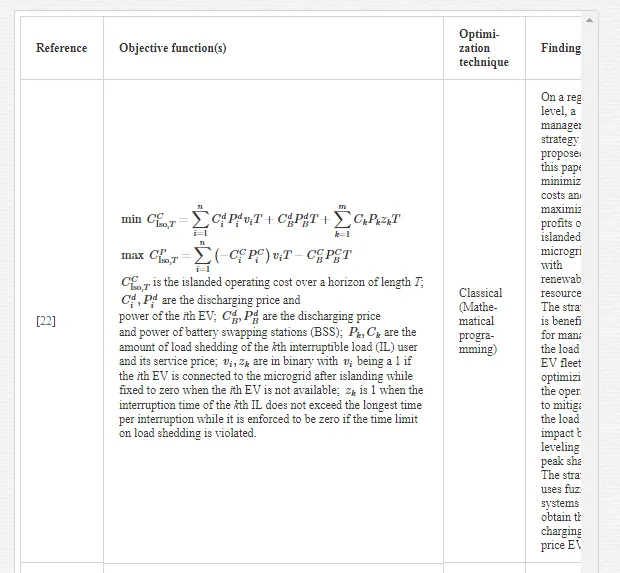
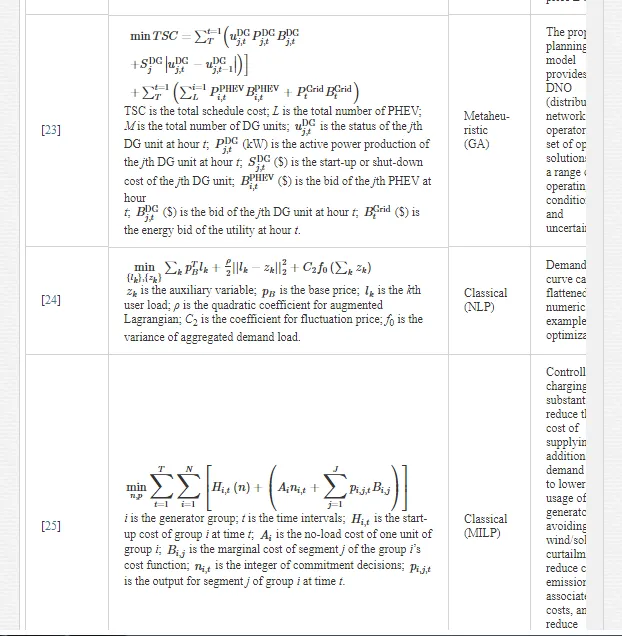
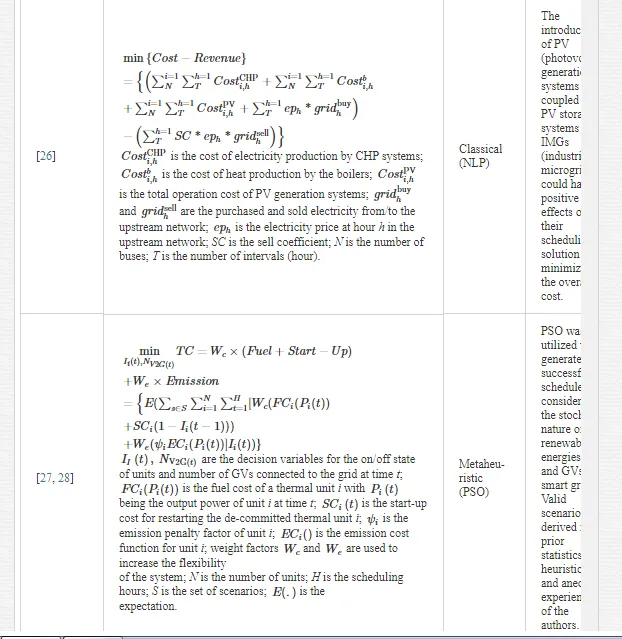
GENERATION COST OPTIMIZATION
Generation cost optimization is crucial to both power distributors, charging station operators, and the EV owners. Interactions between EVs and RESs through the smart grid are at the center of intensive research. Maximizing the profit for distributors, minimizing cost of operation/generation, and the cost of ownership and charging of EV is crucial with the proliferation of green energy [3]. Table 2summarizes the related research works, their objective functions, techniques in use for optimization, and their main findings.
PROFIT/BENEFIT OPTIMIZATION
By maximizing the profit for generators/providers, or the benefits for providing energy, the effects are felt by the supply chain through aggregators, charging stations, etc. down to the EV owners. Optimization is referenced from the viewpoint of increasing investments in RESs or electricity delivery management. Table 3 summarizes the related research works, their objective functions, techniques in use for optimization, and their main findings.
CHARGING COST OPTIMIZATION
Minimizing costs is crucial to both distributors and EV owners. Ensuring that the costs stay low on the distribution side ensures that costs stay low on the consumer side. Maximizing the synergy between stochastic RES generation and EV charging loads is the key to minimizing the costs surrounding EVs [3]. Table 4 summarizes the related research works, their objective functions, techniques in use for optimization, and their main findings.
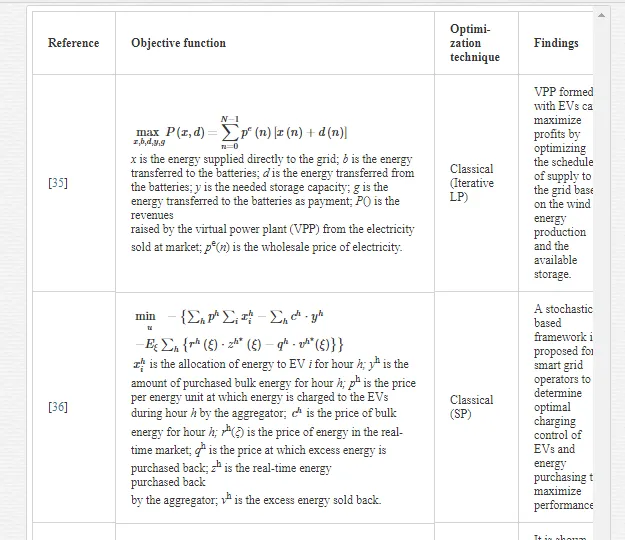
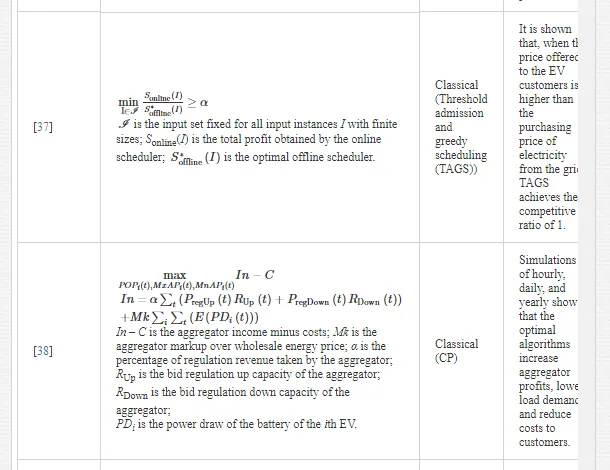
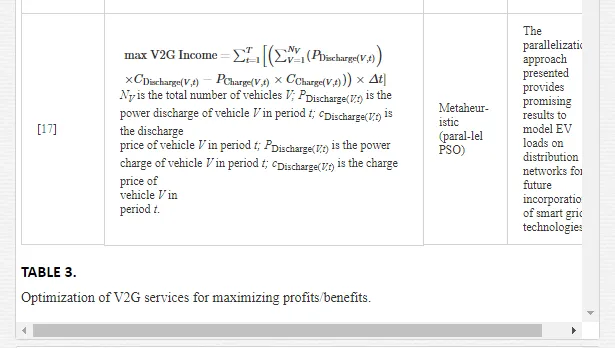
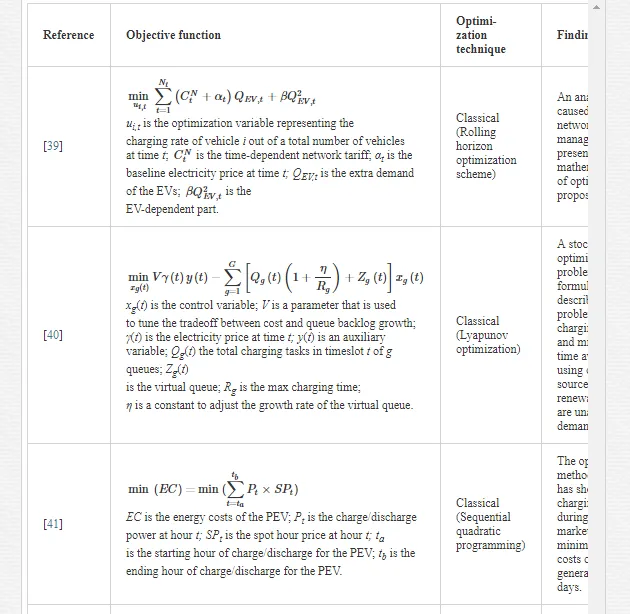
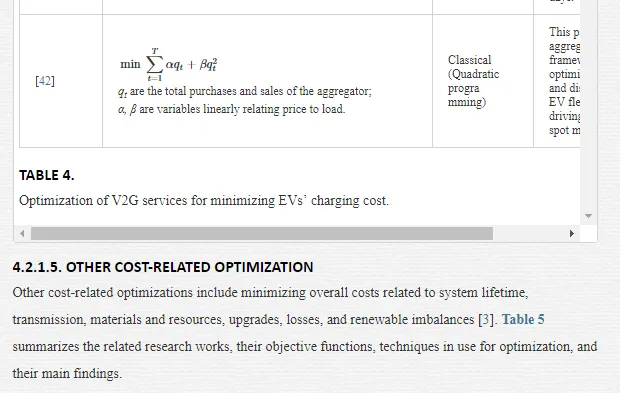
EFFICIENCY OPTIMIZATION
The efficient utilization of renewables can reduce the use of fossil energy quite substantially. This can elicit several benefits including air pollution reduction and cost savings for consumers. The efficiency-related optimization objectives in regards to EVs interactions with RESs are maximizing RES utilization, optimizing energy dispatch, optimizing energy management, minimizing power loss, and minimizing energy loss. Sections 4.2.2.1 and 4.2.2.2 provide details regarding the efficiency-related optimization works for EVs interacting with RESs.
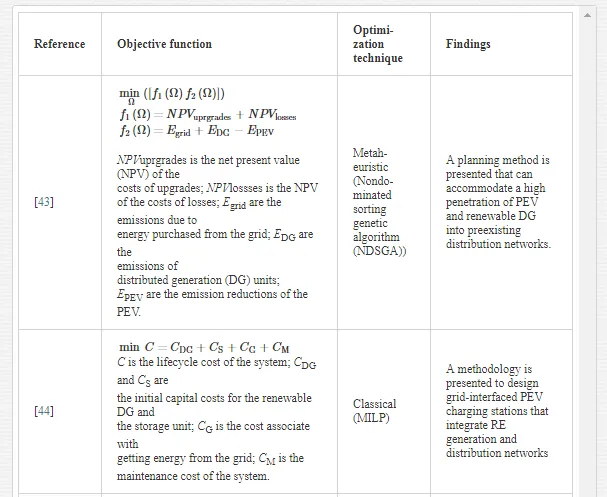
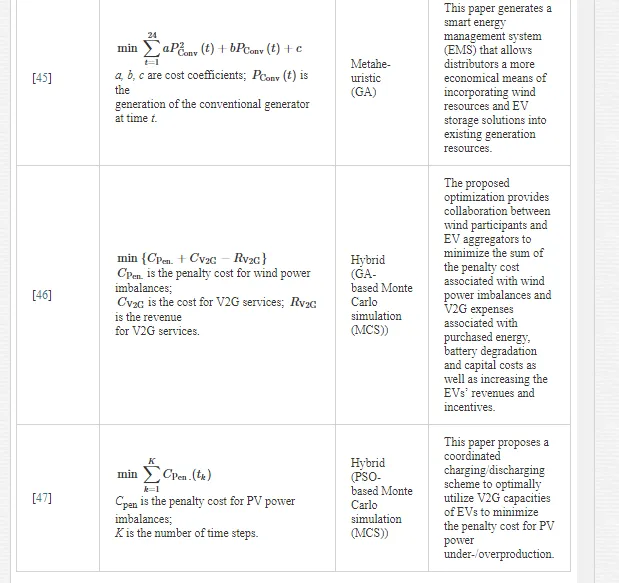
RES UTILIZATION MAXIMIZATION
The excessive power generated by RESs can be stored in batteries of the EV fleets and DC-link capacitors in specialized charging stations to supply the necessary power through V2G infrastructure when the renewable energy generation is insufficient to meet load demands. An optimization strategy is required to coordinate the EVs’ charging/discharging with RESs uncertainties to maximize the use of renewable generation. Table 6 summarizes the related research works, their objective functions, techniques in use for optimization, and their main findings.
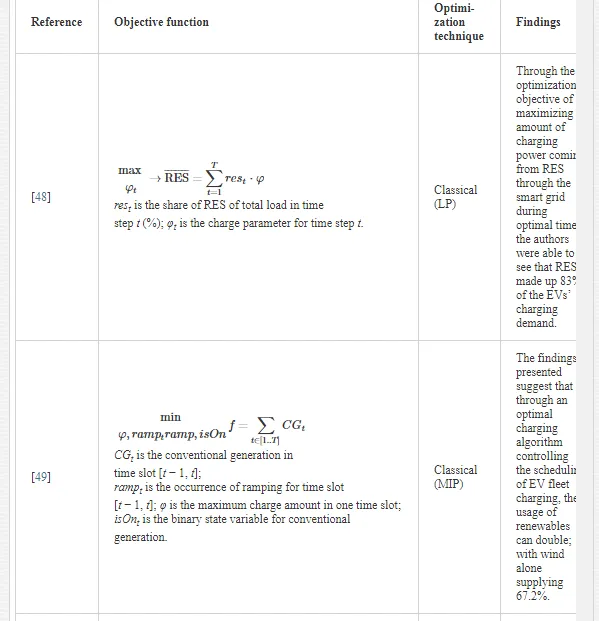
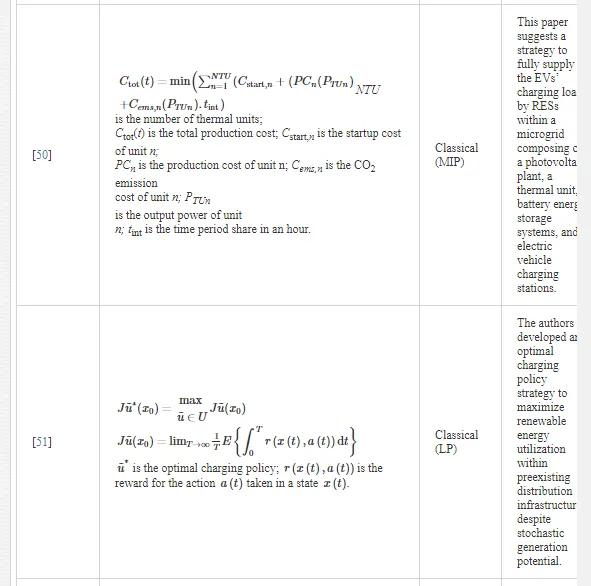
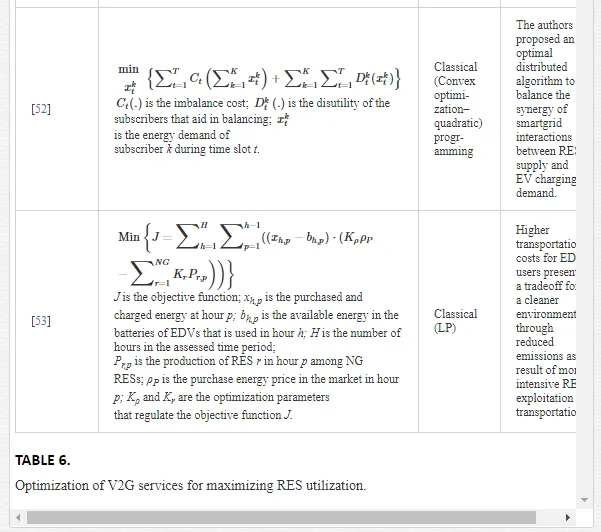
OTHER EFFICIENCY-RELATED OPTIMIZATION
Other efficiency-related optimizations include minimizing imported electricity [54], minimizing power loss [55], minimizing loss energy, and optimizing energy management [56], etc. Table 7 below summarizes the related research works, their objective functions, techniques in use for optimization, and their main findings.
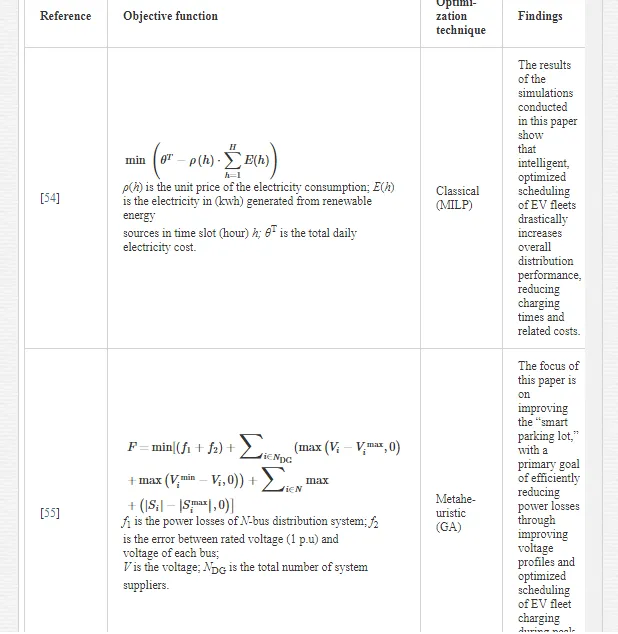
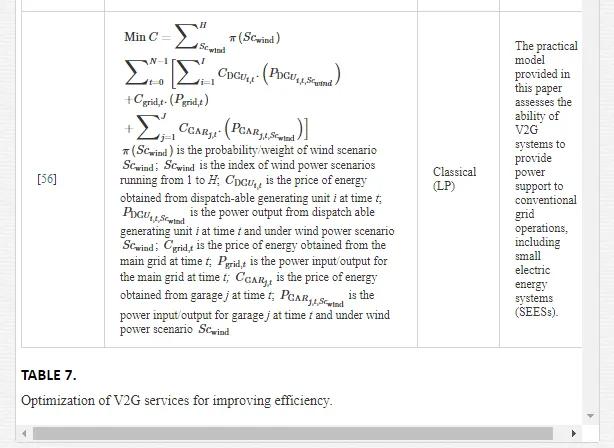
EMISSION OPTIMIZATION
Emission reduction is one of the most important objectives of EVs’ adoption for transportation. This objective can be further satisfied through interactions between EVs and RESs. V2G implementation plays a key role in this scenario to decrease the power utility costs and protect the environment. Related research works include references [27] and [28] of Table 1, reference [43] of Table 5, and reference [57] whose objective function, optimization technique, and its main finding is provided in Table 8.
